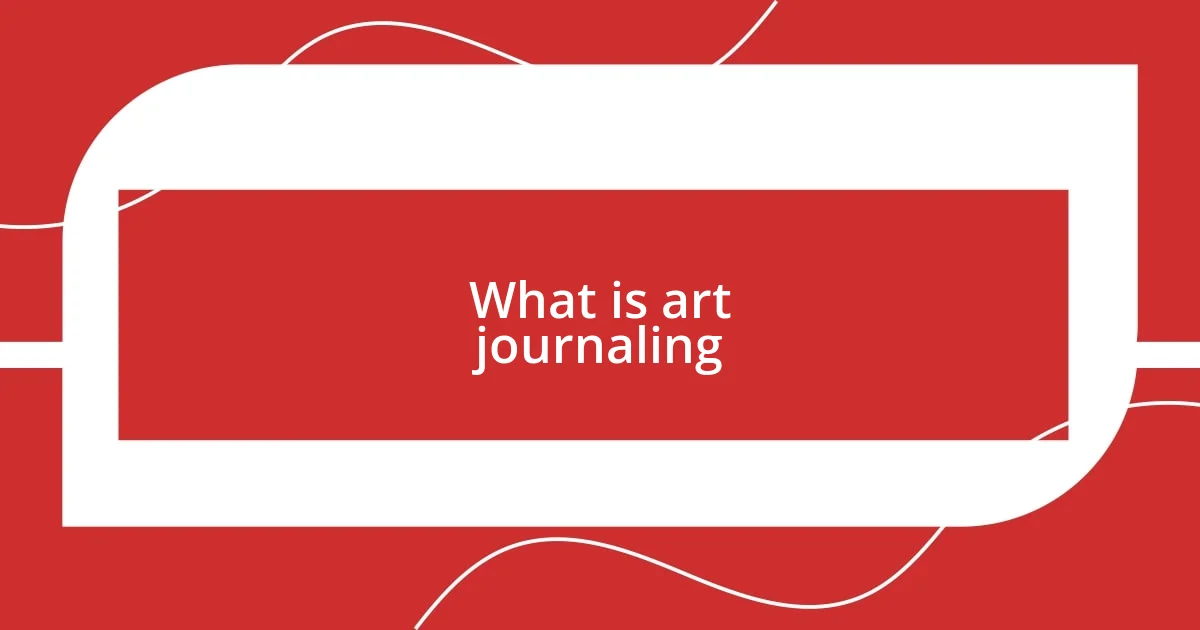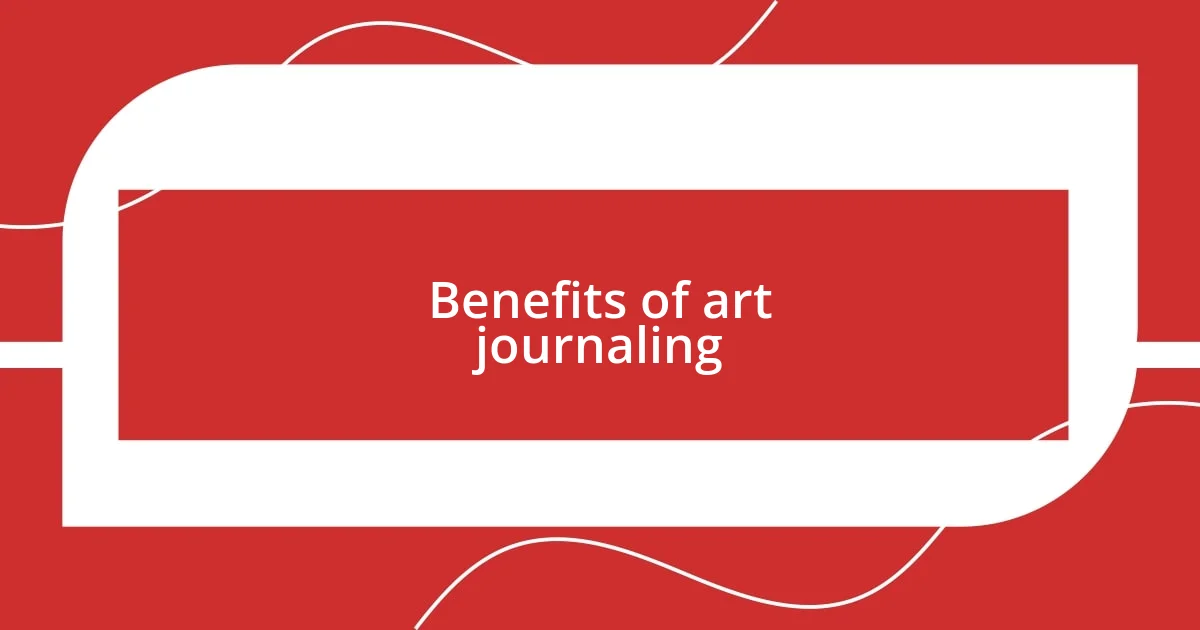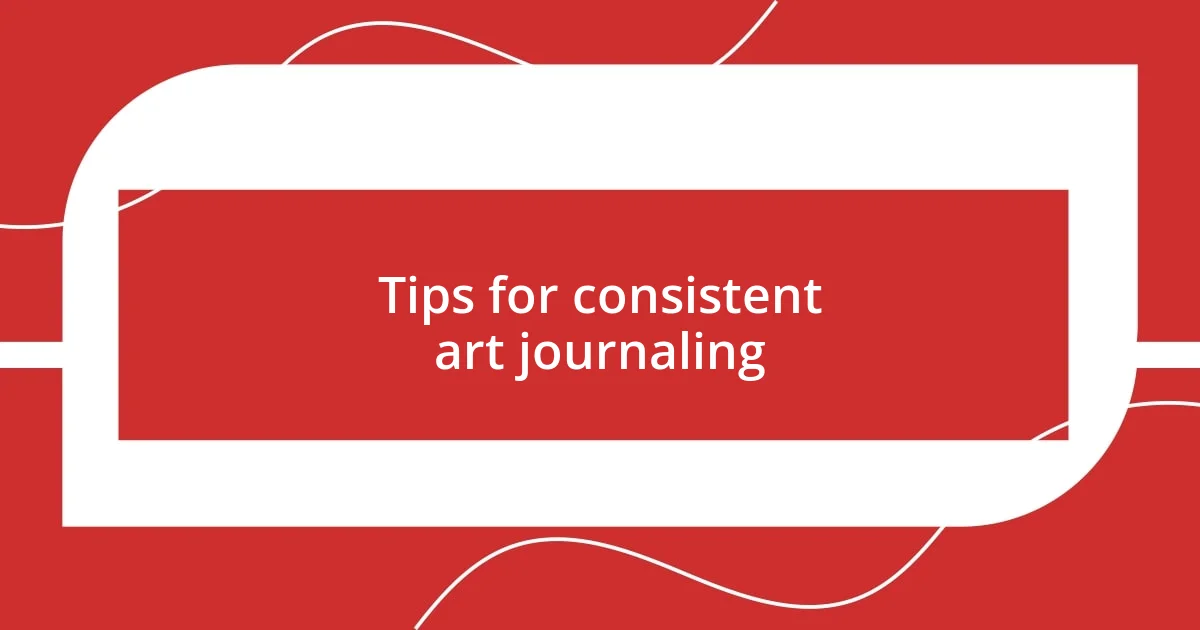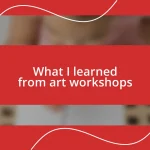Key takeaways:
- Art journaling combines various artistic expressions, facilitating self-discovery and emotional clarity through creative freedom.
- Key benefits include reduced stress, improved mindfulness, enhanced creativity, and personal growth, alongside community building.
- Effective techniques involve layering materials, using prompts for inspiration, and maintaining consistency in practice for deeper exploration.

What is art journaling
Art journaling is a creative practice that combines writing, drawing, and other artistic expressions in a single journal. It empowers individuals to explore their thoughts and emotions visually and textually in a way that’s uniquely personal. I remember my first attempt at art journaling; it felt both liberating and terrifying to put my feelings on a page without the pressure of perfection.
Through my experience, I’ve found art journaling serves as a safe haven for self-discovery. Whenever I’m faced with overwhelming emotions, I turn to my journal to make sense of them. It begs the question: how can something so simple, like scribbling and doodling, bring about such profound clarity and relief? For me, the answer lies in the freedom I feel to express myself without restrictions.
Each page in my art journal is a snapshot of where I was emotionally at that moment, a sort of map of my journey. I’ve poured out joy, sadness, and everything in between, often surprising myself with the revelations that emerge. So, could it be that art journaling functions as both a mirror and a window—reflecting my inner self while allowing me to see the world through a different lens?

Benefits of art journaling
Art journaling has offered me a wealth of benefits that extend well beyond mere creative expression. For instance, I’ve experienced a significant reduction in stress and anxiety whenever I dedicate time to my journal. Putting thoughts into images and words creates a therapeutic effect, enabling me to process feelings and release built-up tension. It’s fascinating how coloring outside the lines can turn chaotic emotions into vibrant pages filled with insight.
Here are some specific benefits I’ve discovered through art journaling:
- Enhanced Emotional Clarity: I’ve often turned to my journal during tough times, and the act of journaling clears my mind like a gentle breeze, revealing what truly matters.
- Improved Mindfulness: While painting or doodling, I find myself fully present, which helps quiet the noisy chatter of daily life.
- Boosted Creativity: I’ve noticed that the more I express myself in my journal, the more spontaneous creativity spills into other areas of my life.
- Personal Growth: Each entry feels like a step in my journey, showcasing how much I’ve evolved over time, which is incredibly empowering.
- Building a Supportive Community: Sharing my art journaling journey has connected me with like-minded individuals who understand the unique challenges and joys of creative exploration.
Art journaling is not just an activity; it’s a transformative practice that nurtures the soul.

Techniques for effective art journaling
To delve into techniques for effective art journaling, I’ve discovered that embracing different methods can amplify the experience. One technique that has helped me tremendously is layering. This involves using different media—like collage, paint, or ink—on a single page. I remember a time when I layered torn pages from a travel magazine with my own watercolors. The process was freeing, allowing me to express the excitement of my adventures while creating a visual story that spoke to my heart. The beauty of layering is that it adds depth and dimension to your journal, making each entry feel like a small masterpiece.
Another technique I’ve found invaluable is using prompts to spark creativity. Sometimes I sit down with zero ideas, and the blank page can be intimidating. In those moments, I turn to prompts like “What color represents my mood today?” or “Draw a memory that makes me smile.” Recently, when I followed a prompt about my favorite childhood memory, I was transported back to a sunny afternoon at the park, and those emotions flowed out of me onto the page. The prompts serve as gentle nudges, helping to open the floodgates of inspiration and making the process enjoyable.
Lastly, I’ve embraced the importance of consistency in my art journaling practice. Scheduling time for my journal, even if it’s just fifteen minutes a day, has fostered a habit that feels natural. It’s surprising how those small moments add up! On days when I feel overwhelmed, just letting my pen or brush move freely often reveals hidden thoughts and emotions. It reminds me that there’s no right or wrong way to express myself—only the freedom to explore.
| Technique | Description |
|---|---|
| Layering | Combining different media like collage, paint, or ink for depth. |
| Using Prompts | Starting with prompts to overcome blank page frustration, prompting creativity. |
| Consistency | Regular practice, even in short durations, helps establish a habit that encourages exploration. |

Materials needed for art journaling
To embark on your art journaling journey, selecting the right materials is essential. I’ve experimented with various supplies, but I always recommend starting with a sturdy sketchbook. There’s something wonderfully inviting about a blank page—and trust me, a thicker paper can handle watercolor and markers without warping or bleeding. I recall my first journal filled with 90-pound paper; every brushstroke felt bold and free.
As for the tools, I find having a variety of pens and pencils is a game-changer. My favorites include fine-tipped markers for detailed doodling and gel pens that bring a pop of color. I vividly remember the joy of adding shimmering details to my pages—who doesn’t love a bit of sparkle? And let’s not forget the wonderful relationship I have with watercolors. They allow me to create dreamy washes and blended colors, evoking emotions I sometimes struggle to express in words. Have you ever experienced the thrill of watching colors merge and flow? It’s pure magic.
Lastly, I encourage you to include other artistic materials like washi tape, stickers, or even scrap paper. The addition of mixed media has transformed my pages into vibrant collages that reflect my mood and experiences. Just last week, I incorporated a torn-out part of an old letter—layering it with vibrant paint brought back a rush of nostalgia. What little treasures might you find around your space to inspire your artistic expression? The journey of finding the right materials can truly enhance your art journaling experience!

Tips for consistent art journaling
Finding a rhythm in art journaling can sometimes feel elusive. One trick I’ve adopted is to treat it like a date with myself. I set aside a specific time each week—whether it’s Sunday mornings with a cup of coffee or quiet Wednesday evenings after dinner. During these moments, I don’t just create; I cultivate a space for reflection. It dawned on me that treating my art journal sessions as sacred moments of self-care allowed the practice to become an integral part of my life rather than a chore.
Another tip that consistently enriches my journaling experience is to keep a dedicated stash of supplies within reach. This might sound simple, but I’ve found that having my materials ready to go makes it easier to dive into my creativity. I remember a late night when inspiration struck, and instead of rummaging through drawers, I simply grabbed my art basket. The excitement bubbled over as I quickly assembled my favorite pastels and markers, ready to capture that fleeting idea. Having everything organized prevents procrastination and ignites my passion on those spontaneous creative whims.
Finally, I realized the power of mixing up my journaling activities. Sometimes I’ll sketch, other times I’ll write, or even try my hand at collage. I like to think of it as a creative buffet! When I’m feeling stuck, I challenge myself to explore a new technique, like experimenting with bold color palettes or trying out new textures. Just last week, I painted with my fingers for the first time, and I was ecstatic! That sensory connection sparked an overwhelming joy in my work, reminding me that art should be a playground. What new experiences are you ready to discover in your own journaling journey?

Reflecting on your art journal
Reflecting on your art journal offers a remarkable opportunity to connect with your inner self. As I flip through my pages, I often find memories flooding back—thoughts and feelings that I had tucked away but that emerge vividly through my sketches and words. Have you ever noticed how a simple doodle can transport you back to a specific moment in time? For me, a swirling pattern can evoke an entire day filled with laughter and warmth.
I also believe that the act of reflection can reveal growth in our artistic journey. As I study older entries, I often chuckle at my evolving style and the emotions captured on the page. One evening, I stumbled upon a piece I created during a particularly challenging time in my life. The darker colors I used reflected my struggles, but seeing how far I’ve come ignited a sense of gratitude within me. How has your art journal mirrored your own growth?
Moreover, reflecting on my art journal turns into a form of self-discovery. I like to use prompts to guide my thoughts—questions like, “What did I learn today?” or “What colors resonate with my current feelings?” Recently, I wrote about the overwhelming joy I experienced after trying to paint a sunset for the first time. Capturing those emotions not only made my pages more colorful but also taught me to embrace vulnerability through my art. What lessons might be waiting for you in your pages?















